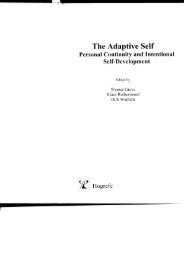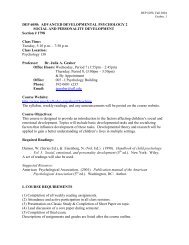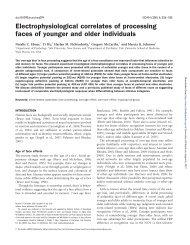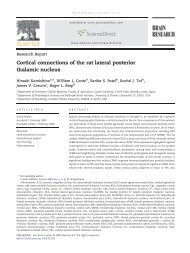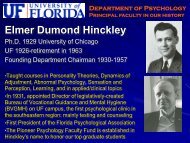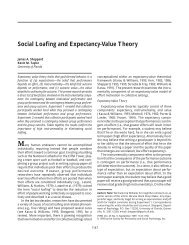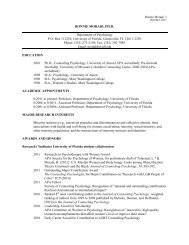Personality theories of successful aging - University of Florida ...
Personality theories of successful aging - University of Florida ...
Personality theories of successful aging - University of Florida ...
Create successful ePaper yourself
Turn your PDF publications into a flip-book with our unique Google optimized e-Paper software.
Personulity Theorie s <strong>of</strong> Successful Aging 113<br />
lction, optimization, and<br />
rm a preference study on<br />
6-434.<br />
es <strong>of</strong> selection, optimizarstruct<br />
validity. lotrnal <strong>of</strong><br />
from promoting gains to<br />
a (Eds.), The adaptizte self:<br />
l). Ashland, OH: Hogrefe<br />
elopment and <strong>aging</strong>: The<br />
;sful <strong>aging</strong>. In J. Brandtry<br />
and research through the<br />
M Lerner, M. A. Easterogy:<br />
Vol. 6. Deaelopmental<br />
rf personality and devel-<br />
-Iandbook<br />
<strong>of</strong> personality det.<br />
Higgins & R. M. Sor-<br />
'ndations <strong>of</strong> social behaaior<br />
f action: Linking cognition<br />
rn and cognition. In E. T.<br />
rdbook <strong>of</strong> basic principles<br />
f the life story in adoles-<br />
Tibbitts, & W. Donahue<br />
:tiaes (pp. 299-320). Nen'<br />
ld: Primary and secondt,176-787.<br />
normatiae and sociost r ucriversity<br />
Press.<br />
:ol. Psychological Reuiezu,<br />
in adulthood: Selection<br />
ckhausen & C. S. Dweck<br />
C-77). New York: Cam-<br />
,ulation in adulthood: Opcript,<br />
Max Planck Insti-<br />
I regulation before and<br />
al clock" for childbear-<br />
Helson, R., & Kwan, V. S. Y. (2000). <strong>Personality</strong> development in adulthood: The broad picture<br />
and processes in one longitudinal sample. In S. Hampson (Ed.), Adoances in personality<br />
psLtcholo;qy (Vol. 1, pp. 77-106). London: Routledge.<br />
Isaacowitz, D. M., & Smith, l. (2003). Positive and negative affect in very old age. lournals<br />
<strong>of</strong> CerontolLtgy, 588, P743-P152.<br />
Jopp, D. (2002). Successful <strong>aging</strong>: On the ftrnctional interplatl between personal resources<br />
and adaptiae life-managenrent strategies. Doctoral dissertation, Free <strong>University</strong> <strong>of</strong><br />
Berlin.<br />
Kemper, S., Herman, It. E., & Lian, C. H. T. (2003). The costs <strong>of</strong> doing two things at once<br />
for young and older adults: Talking while walking, finger tapping, and ignoring<br />
speech or noise. Psychology nnd Aging, 18,181-192.<br />
Klinger, E. (1975). Consequences <strong>of</strong> commitment to and disengagement from incentives.<br />
Psychological Reaieitt, 82, 1-25.<br />
Klinger, E. (1977). Menning and uoid: Inner experience nnd the incentiues in people<br />
's /lzres. Minneapolis:<br />
<strong>University</strong> <strong>of</strong> Minnesota Press.<br />
Krampe, R. T., & Baltes, P. B. (2003). lntelligence as adaptive resource development and<br />
resource allocation: A new look through the lenses <strong>of</strong> SOC and expertise. In R. J.<br />
Sternberg & E. L. Crigorenko (Eds.), Perspectiaes on tlte psychology <strong>of</strong> abilities, cornpetencies,<br />
nnd expertise (pp. 31-69). New Ycrrk: Cambridge <strong>University</strong> Press.<br />
Krampe, R. T., Rapp, M. A., Bondar, A., & Baltes, P. B. (2003). Allocation <strong>of</strong> cognitive resources<br />
during the simultaneous performance <strong>of</strong> cognitive and sensorimotor tasks.<br />
Der Ne rue nnrzt, 7 4, 271-278.<br />
Kruglanski, A. W. (1996). Coals as knowledge structures. ln P. M. Collwitzer & J. A. Bargh<br />
(Eds.), The pstlchologq <strong>of</strong> action: Linking cogttition and ntotiantion to behaaior (pp. 599-618).<br />
New York: Springer.<br />
Kunzmann, U. (1999). Being nnd feeling in control: Trtto sources <strong>of</strong> older people's emotional uellbeing.Berlin,<br />
Cermany: Max Planck Institute for Human Development.<br />
Labouvie-Vief, C. (1981). Proactive and reactive aspects <strong>of</strong> constructivism: Crowth and<br />
<strong>aging</strong> in Iife-span perspective. In R. M. Lerner & N. A. Busch-Rossnagel (Eds.), Indioidttals<br />
as producers <strong>of</strong> their deoelopment: A life-spnn perspectizte (pp.I97-230). New York: Academic<br />
Press.<br />
Lang, F. R., Rieckmann, N., & Baltes, M. M. (2002). Adapting to <strong>aging</strong> losses: Do resources<br />
facilitate strategies <strong>of</strong> selection, compensation, and optimization in everyday functioning?<br />
lournal <strong>of</strong> Gertmtttlogy: Psychological Sciences, 578, 507-509.<br />
Lawton, M. P. (1975). The Philadeiphia Geriatric Center Morale Scale: A revision. lournal<br />
<strong>of</strong> Gerontology , 30 , 85 -89 .<br />
Lawton, M. P. (1983). Environment and other determinants <strong>of</strong> well-being in older people.<br />
Gerontolog ist, 23, 349-357.<br />
Lawton, M. P. (1989). Environmental proactivity in older people. In V. L. Bengston &<br />
K. W. Schaie (Eds.), Tlrc corrrse <strong>of</strong> lnter life: Resenrch and rtflections (pp. 15-23). New York:<br />
Springer.<br />
Lawton, M. P., & Nahemow, L. (7973). Ecology and the <strong>aging</strong> process. In C. Eisdorfer &<br />
M. P. Lawton (Eds.), The psychology <strong>of</strong> adult deoeloTtntent nnd <strong>aging</strong> (pp. 619-674). Washington,<br />
DC: American Psychological Associatron.<br />
Lee, A. Y., & Aaker, J. L. (2004). Bringing the frame into focus: The influence <strong>of</strong> regulatory<br />
fit on processing fluency and persuasion. lottrnal <strong>of</strong> Persttnalittl nnd Social Psychology,<br />
86,205-278.<br />
Lerner, R. M., & Busch-Rossnagel, A. (1981). Indiaidunls ns producers <strong>of</strong> their deuelopment: A<br />
life-span perspcctiue. New York: Academic Press.



